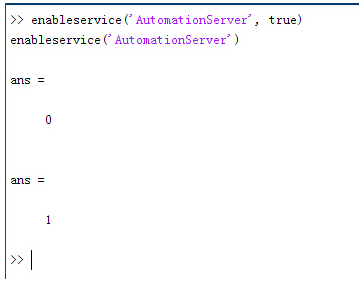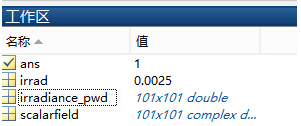jYA�D�9�v% 简介:
FRED作为COM组件可以实现与Excel、VB、
Matlab等调用来完成庞大的计算任务或画图,本文的目的是通过运行一个案例来实现与Matlab的相互调用,在此我们需要借助脚本来完成,此脚本为视为通用型脚本。
%E� q}��H g��~�FA:R� 配置:在执行调用之前,我们需要在Matlab命令行窗口输入如下命令:
�m`(5��B� enableservice('AutomationServer', true)
E. @�n Rj# enableservice('AutomationServer')
r5�ON�Aa3.  ?m�3,e&pB5
?m�3,e&pB5 结果输出为1,这种操作方式保证了当前的Matlab实体可以用于
通信。
N*.JQvbnr #R&D���gt
在winwrp界面,为增加和使用Matlab类型的目录库,我们需要如下步骤:
aa�!o:��:; 1. 在FRED脚本编辑界面找到参考.
|�G.|ocj�; 2. 找到Matlab Automation Server Type Library
�\i��Fh-?( 3. 将名字改为MLAPP
;q:�.&dak1 Y\!* c�=@k L\L/+yNv:G 在Matlab里面有两种常用的数据发送选项PutWorkspaceData 及PutFullMatrix,PutWorkspaceData适用于存储一般的数据在工作区,并赋予其为变量,PutFullMatrix试用于复数数据。
NFT&\6��!o 图 编辑/参考
-h&�AO\*^W T/NeoU3 p c#eV!fl>&� 现在将脚本代码公布如下,此脚本执行如下几个步骤:
��I$@0F�Sl 1. 创建Matlab服务器。
�X�) lz�BM 2. 移动探测面对于前一聚焦面的位置。
=5be�f8��O 3. 在探测面追迹
光线 {"<�D$*K~� 4. 在探测面计算
照度 W7�9w�z\a 5. 使用PutWorkspaceData发送照度数据到Matlab
Bob K�>�db 6. 使用PutFullMatrix发送标量场数据到Matlab中
�69)-� )en 7. 用Matlab画出照度数据
�E0XfM B]+ 8. 在Matlab计算照度平均值
e 5hq�>�K 9. 返回数据到FRED中
}EB/��1��8 5��[Sa7M�k 代码分享:
u~Z���x9>f /�]~Oa#SQ: Option Explicit
{ETuaFDM�� ?[�#nh@mI� Sub Main
>�sW9n��[ $[5S M>�e] Dim ana As T_ANALYSIS
����[R�$iX Dim move As T_OPERATION
�.W�_'�6Q+ Dim Matlab As MLApp.MLApp
HyKvDJ
3_� Dim detNode As Long, detSurfNode As Long, anaSurfNode As Long
�C*A!`Q?1Y Dim raysUsed As Long, nXpx As Long, nYpx As Long
=�<ngt�N Dim irrad() As Double, imagData() As Double, reals() As Double, imags() As Double
��<�d".v Dim z As Double, xMin As Double, xMax As Double, yMin As Double, yMax As Double
v8�Ga@*��� Dim meanVal As Variant
y; LL^:rq d��f�}DJB� Set Matlab = CreateObject("Matlab.Application")
n&V���\s�0 �.(T*�mk*> ClearOutputWindow
�BeAkG_u�G &rY73�qfP' 'Find the node numbers for the entities being used.
SGi��(Zk�c detNode = FindFullName("Geometry.Screen")
N?]H�WP^pg detSurfNode = FindFullName("Geometry.Screen.Surf 1")
~(W�q 5�<v anaSurfNode = FindFullName("Analysis Surface(s).Analysis 1")
1�5NeC7GAh A�e�,P&��( 'Load the properties of the analysis surface being used.
EqW�/Wxv7b LoadAnalysis anaSurfNode, ana
'!8'Xo@Go3 (�* WO�<V� 'Move the detector custom element to the desired z position.
D�bRq�,T�� z = 50
{�OA�2';3� GetOperation detNode,1,move
C"`,?K(U�� move.Type = "Shift"
p�Y75S�5h: move.val3 = z
M^f�+R�'Q3 SetOperation detNode,1,move
H��_H3�Gp Print "New screen position, z = " &z
�luNEg��Cq �5O�h>r�K( 'Update the model and trace rays.
d|T87K>|r" EnableTextPrinting (False)
`;?`X��C"m Update
[wHG�t?R�� DeleteRays
rVo0H.+N)` TraceCreateDraw
��v�(5zS�o EnableTextPrinting (True)
:Fe}.*� t� #�9S�rc\V 'Calculate the irradiance for rays on the detector surface.
7OF�6;�@<� raysUsed = Irradiance( detSurfNode, -1, ana, irrad )
ces|HPBa&6 Print raysUsed & " rays were included in the irradiance calculation.
-_<rmR�[:] �E?,O>bCJ5 'When using real number data to send to MATLAB, it is simplest to use PutWorkspaceData.
�JL[xr�K0� Matlab.PutWorkspaceData("irradiance_pwd","base",irrad)
O7&���6]/` $��C�T��2E 'PutFullMatrix is more useful when actually having complex data such as with
-u!{8S~wA 'scalar wavefield, for example. Note that the scalarfield array in MATLAB
mU
�d['�Z 'is a complex valued array.
7RE'KH�_$ raysUsed = ScalarField ( detSurfNode, -1, ana, reals, imags )
PH6!�T/2[ Matlab.PutFullMatrix("scalarfield","base", reals, imags )
rd#�O �] � Print raysUsed & " rays were included in the scalar field calculation."
/*v}�.�fH% ZboY]1�L[j 'Calculate plot characteristics from the T_ANALYSIS structure. This information is used
�h^Bp^V5#� 'to customize the plot figure.
�.(D,CGtYb xMin = ana.posX+ana.AcellX*(ana.Amin-0.5)
Cp[{|�U-?G xMax = ana.posX+ana.AcellX*(ana.Amax+0.5)
��9Tju+KcK yMin = ana.posY+ana.BcellY*(ana.Bmin-0.5)
=�\[��}@Kh yMax = ana.posY+ana.BcellY*(ana.Bmax+0.5)
_ML�`Vh��] nXpx = ana.Amax-ana.Amin+1
�ix�.I)� nYpx = ana.Bmax-ana.Bmin+1
6
�07"�Z�\ )�21yD1"�6 'Plot the data in Matlab with some parameters calculated from the T_ANALYSIS
�w��t�m=� 'structure. Set the axes labels, title, colorbar and plot view.
&\w:jI44Bs Matlab.Execute( "figure; surf(linspace("&xMin &","&xMax &","&nXpx &"),linspace("& yMin &"," & yMax & "," & nYpx & "),irradiance_pwd, 'EdgeColor', 'None');" )
=Fu~ 0W��c Matlab.Execute( "xlabel('X Position (" & GetUnits() & ")')" ) : Matlab.Execute( "ylabel('Y Position (" & GetUnits() & ")')" ) : Matlab.Execute( "zLabel( 'Irradiance' )" )
�)I/K-�z�j Matlab.Execute( "title('Detector Irradiance')" )
TO�H!v�Q�P Matlab.Execute( "colorbar" )
qK�L�:#�ny Matlab.Execute( "view(2)" )
�1$A7��BP Print ""
|3ob1/)p0� Print "Matlab figure plotted..."
NG��)Xk[q4 ��T~&9/%$F 'Have Matlab calculate and return the mean value.
o��Qs�ls9t Matlab.Execute( "irrad = mean(mean(irradiance_pwd));" )
h�XF#K�Vqx Matlab.GetWorkspaceData( "irrad", "base", meanVal )
qj�$6/V|�D Print "The mean irradiance value calculated by Matlab is: " & meanVal
GxFmw��: A9:dHOmT^U 'Release resources
�f`���^�\v Set Matlab = Nothing
?G|���*=-8 c)5d-��3"� End Sub
oZ
�CvEVUk �2��95��U< 最后在Matlab画图如下:
dE� ,NG)MH #Y���EOY#� 并在工作区保存了数据:
Y1=.46Ezf�  n#��\ t_/\
n#��\ t_/\ 并返回平均值:
P��F6w'T 5 S�(&]��?!� 与FRED中计算的照度图对比:
��+�?�&|p0 n"G�ow/�-; 例:
O �/S�:�S 8�D�)I~0\ 此例
系统数据,可按照此数据建立
模型 AbXaxt/[g? �x!@���3.$ 系统数据
w%Bo7 'o)V et-�<ib<lY ";>>{lYA�. 光源数据:
BZdryk��:S Type: Laser Beam(Gaussian 00 mode)
ko�T�b{U�L Beam size: 5;
�da,;IE{1u Grid size: 12;
4I�q-4IG( Sample pts: 100;
0�Qa�k�F�t 相干光;
M@��wQ�6ow 波长0.5876微米,
��)���{_�D 距离原点沿着Z轴负方向25mm。
�*��
1�1|P "&@v[O)!xu 对于执行代码,如果想保存图片,请在开始之前一定要执行如下代码:
�_7^4sR8=� enableservice('AutomationServer', true)
d��^�.��@~ enableservice('AutomationServer')